Come in to my garden while I look for photos:
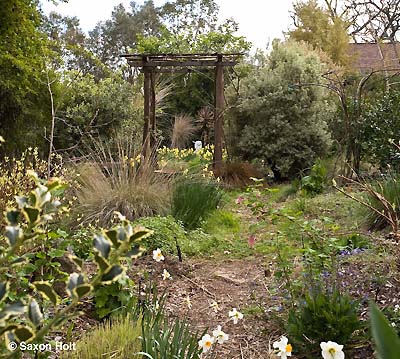
Some days you just know the garden needs to be photographed but can’t quite find the photo or don’t know quite where to start. The first and most important lesson to taking a good photo is ….. grab the camera and go to it. You can’t take a great picture if you don’t start.
So let’s start in my garden looking along the long axial view in the front garden. In one regard it is a mess: weeds, pruned clippings everywhere, dormant shrubs, and the paths have not been raked this year. But my daffodils are at peak bloom and I will go toward the daffodil meadow. The rustic pergola that I made from tree saplings should be a good place to frame up a picture:
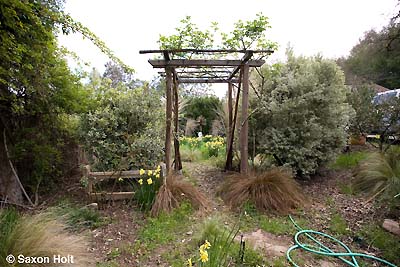
OK, things are about to happen. The first thing to notice is I have changed lenses. While the pergola is more or less still in the center of the photo I am much closer to it but with a much wider lens. In the first frame I used a long telephoto lens that emphasizes the long view down the garden, but now I want to frame the pergola and invite the viewer into the garden room beyond. To do this I must carefully frame the photo – no hoses, no unnecessary space that does not contribute to the photo.
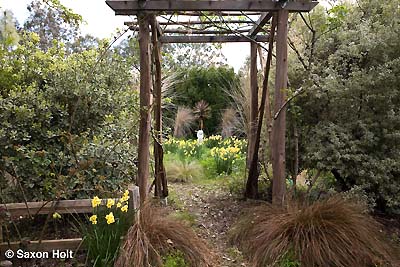
I have not moved the camera at all, but changed lenses to frame up a nice photo, which says a lot about the garden. Every part of the frame is important to both the composition and the message. On either side are shrubs that create the walls separating the 2 garden rooms. (Pittosporum tobira Variegata on the left, P. tenuifolium ‘Marjorie Channon’ on the right). In the foreground we see just a piece of the split rail fence which I use as visual decoration but gives the garden (and photos there-in) a stronger sense of separation. (In front of the fence is Rose ‘Mme Isaac Pereire’, climbing on the pergola are 2 Rose ‘Lavender Lassie’, in front are 2 Carex secta ‘Western Hills’ in ruddy winter color with Narcissus ‘Martinette’)
Now that we are invited into the daffodil meadow, let’s go in, slowly:
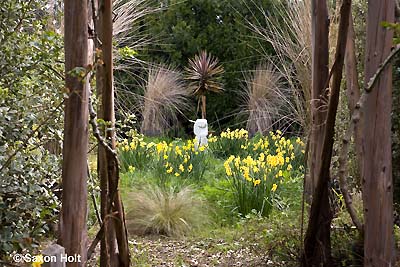
First, notice again I have not moved the camera, but have now put on a telephoto lens to pull the eye through the pergola into the meadow. Again in this composition, every part of the frame is important. Study all the elements noting blocks and shapes. In the next frame I will actually move into the daffodil meadow, but before we move, look back where we have come from. There are many photography lessons to be learned from staying in one place while you look for photos in any garden. Take your time to think about what is going on, drink it in. On those days when the garden is being photographed, consider context, details, juxtapositions, viewpoints, framing. Not every place you rest your eye or investigate with your camera is going to make a photo, but every part of the garden should be considered as you think about what you are feeling and think about how to illustrate it.
So, what is in this daffodil meadow?
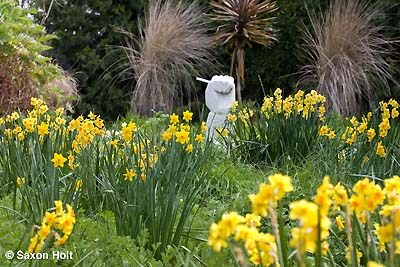
I am now in the pergola but have lowered the camera and tripod so my point of view is just above eye level of the daffodils. (Most of these are the Tazetta narcissus ‘Falconet’). The small statue (‘Peace Fist’ by Warren Arnold) gives the entire garden a focal point which will be swallowed up later in the spring when the wildflowers take over. Now the Phacelia, Clarkia, Eschscholzia, are just a green fuzz. At the end of the meadow, against a dark green tall hedge of arborvitae, Calocederus decurrens – Incense Cedar, are containers of 2 Miscanthus juncatus and a Cordyline, all 3 of which desperately need repotting.
I ventured out with my camera because I knew I wanted to photograph the daffodils. I found them in my meadow garden, backed by a dark green hedge with wisps of ornamental grass, a simple white statue, and some green wildflower fuzz.
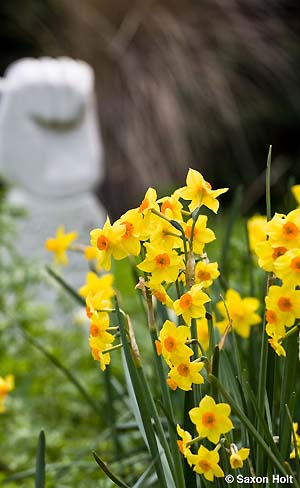
A simple photo really; but it took a while for me to find it.
